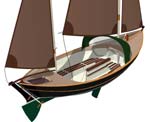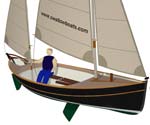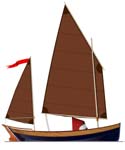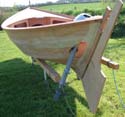Storm 17 is a new family
day boat designed and built by Swallowboats,
on the West Coast of Wales, in the UK. Swallowboats generally
make traditionally inspired kit boats for foreign and domestic
markets, and pride themselves on the creating easily reproduced,
aesthetically pleasing designs.
We thought Duckworks readers may be interested in progress to
date in developing this new craft and would certainly welcome
any comments you have, which can be left on our website.
Her design brief was for an elegant, lightweight (easily trailerable)
means to enjoy sailing with one’s family, or alone. It is
our intention to sell her as plans, a kit or complete so she must
be straightforward for the home builder. We wanted her to be capable
of camp cruising with two sleeping on board under a boom tent
or other cover. She had to be European-Union-proof (lots of buoyancy)
and have dry stowage, with a means for crew members to keep out
of the rain, (or in the shade). At the same time, to carry an
outboard motor, with an easily handled rig and oars for those
who prefer, when the wind dies.
 click to enlarge
click to enlarge |
The work started on her design back in August 2003. We use a
combination of techniques to design our boats, starting with a
computer but relying heavily on physical models in thin plywood
or cardboard to help us visualize what she will look like. In
spite of this it took us a long time to get a shape that we felt
really had the look we were after in addition to satisfying the
design brief.
Initially we had favoured a scaled up version of our popular
14ft Storm Petrel design, but it wasn’t long before a few
changes were made to this faering-style concept. The most obvious
was to make the bow profile more vertical, as much as we could
within the constraints of the plywood bottom panels. (She is shallow
v-bottomed, not flat bottomed). Most people who have built boats
from developable plywood panels know the forces can be large when
bending up towards the bow, and for this reason special 6mm 3-ply
has had to be used with a layer of external glass to give improved
abrasion resistance. The steeper bow profile will give greater
speed and finer waterlines, improving her seakeeping in choppy
waters. We also think it improves her looks, though obviously
beauty is in the eye of the beholder...
 Tiller (click to enlarge)
Tiller (click to enlarge) |
Another change from the 14ft Storm was the addition of a mizzen.
It will help provide more reefing options, and a lower centre
of effort as well as point her head to wind in any conditions
should the need arise. This gave us the usual dilemma of what
to do with the tiller, and we favoured an option we have used
on two previous boats. The tiller is aft of the mizzen, which
is supported by the aft bulkhead. A close up of what I mean is
shown in the picture (above, left). The tiller will also
have an extension for sailing singlehanded, when it is anticipated
the helmsman will have to sit a little further forward unless
carrying stores up in the bows.
The mainsail will be a gunter rigged with sprit boom, a combination
we feel is very versatile and inexpensive to build and maintain.
The spars can be stored in the boat and are light enough for any
adult to step and rig her without difficulty. Roller reefing for
the jib is anticipated to make life easier for those who intend
to leave her at a mooring, though it can be a mixed blessing when
trailing her, so will be optional in our kits.
 Traditional Rig
Traditional Rig |
There will also be a choice of rigs available, a more normal
Bermudan arrangement and a more traditional cat ketch are shown
on our website.
The rudder is similar to that used on many of our boats. More
racing inclined sailors comment that it looks too small, though
this has never been reflected in our experience. It is mounted
on five bronze gudgeons (two on the rudder, three on the stern
post, in traditional manner) that allow it to rise up on the inclined
stern post when grounding. A haul up line will also be employed
for sailing in very shallow water.
We have added a centreboard, which unfortunately sits right in
the way of the camp-cruising requirement in her design brief.
We toyed with the idea of bilgeboards or bilgerunners, but have
had little luck with them in the past (we’ve tried a lot).
We then reasoned that by keeping the side seats slightly lower
than usual and the centre board case as low as sailing requirements
allow, it’s possible to brace removable slats across the
seats, thus raising the sleepers up to give them almost the full
width of the boat in elbow room when lying down with feet towards
the bow.
The side seats are wide and comfortable. When sailing in the
summer they will be great for a passenger to stretch out on and
grab a few minutes shut-eye. For most of their length they form
sealed buoyancy chambers, but up forward under the foredeck, they
create large semi-dry stowage containers. (By semi-dry, I mean
they will only get wet if you capsize). Totally dry storage is
available in the for’d and aft buoyancy compartments, through
large watertight hatches.
 Outboard well
Outboard well |
One noticeable feature of this boat is her wrap around cockpit
coamings. These have been angled to provide comfortable backrests
in addition to deflecting water off the decks through the scupper
holes in the side. Another slightly different aspect to this boat
is the outboard well. Considerations in fitting it were: to allow
kick up if run aground, to minimise the size of the hole in the
hull, to make the hole above the waterline if possible, to allow
continuous use of the rudder (and tiller) when the outboard is
up or down and to exceed the minimum down-flooding heights needed
under the EU recreational craft directive. We eventually settled
the outboard in a well of its own in the aft deck, but to clear
the rudder, the bottom has to be tilted outwards about 20 degrees.
The direction of the prop thrust is still parallel to the keel
and adjustable by steering with the outboard, although it is anticipated
that when under power the motor is locked and the rudder used
to steer. We were initially concerned that particularly 4-stroke
outboards would suffer when run at a sideways tilt of 20 degrees,
but engine manufacturers assure us it will be no problem.
I would like to compete with her next year in “Sail Caledonia”
an event similar to your messabouts in the US except held over
5 days and organised as a race under sail and oar through the
Caledonian Canal in Scotland. For this reason she would benefit
from having two rowing positions fore and aft, braced from the
centreboard case. In any event two rowing positions are handy
to maintain boat trim when under a variety of load cases.
 (click to enlarge)
(click to enlarge) |
The centreboard case is supported by a cross thwart from the
side benches. This allows crew members to sit under the shelter
of the large spray hood, which folds down to lie on the foredeck,
hidden in profile by the deck coamings. This hood just clears
the foot of the main sail and will probably be used as a start
point for a cockpit tent, the details of which are yet to be worked
out.
An anchor could be stored in a box just forward of the centreboard
case, ready for easy access, and one of the storage lockers could
easily be turned into a cool box with the addition of some insulation.
We are also thinking of adding a bowsprit to fly an additional
jib or asymmetric spinnaker for those that want a little extra
speed. Her standard sail area of 130sq ft may be just a touch
on the high side, but she should be easily reefed. For even stronger
winds, the ability to perform well under jib and mizzen only is
one of the great advantages to this rig.
You can follow her progress on our website www.swallowboats.com/storm17.htm
There you can see the latest build progress and leave comments
or suggestions to help us develop this boat in the future.
Matt Newland

|

